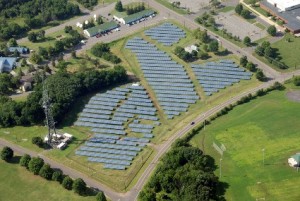New Jersey taxpayers could net $36.9 million per year, $369 million over 10 years, with the installation of 152.5 megawatts (MW) of photovoltaic (PV) solar electricity systems on public schools, community colleges, and each of the public universities in the state.
The systems would pay for themselves within the first 8 years. At 2010 values of electricity and Solar Renewable Energy Certificates (SRECs), these systems would generate electricity worth approximately $300 Million and SRECs worth $1.2 Billion over the first 10 years, approximately $369 Million in excess of the cost of the systems, and provide virtually free electricity over the remainder of their 35 to 40 year lifespan.
Widespread deployment of solar energy increases the resilience of the electric grid, strengthens national security and can enhance local emergency response capabilities.
These are the conclusions of a feasibility study by Lawrence J. Furman, principal of Furman Consulting Group, LLC during the course of his studies for an MBA in Managing for Sustainability at Marlboro College Graduate School.
The money saved is a function of the number and capacity of the PV solar systems, installation costs, financing costs, electricity costs, and SREC values.
The study modeled the installation of 152.5 megawatts, MW, of photovoltaic, PV, solar, as:
- A 50 KW PV solar array on each of the 2,500 public schools,
- A 500 KW PV solar array on each of the 19 community colleges,
- A 1.5 MW, PV Solar array on each of the 12 public colleges and universities.
The study assumed:
- Installation costs of $6.00 per watt, $300,000 for a 50 kilowatt, or KW, system.
- Bond financing at 5% for 10 years,
- Electricity prices fixed at 2010 levels for 10 years,
- Solar Renewable Energy Certificates, SRECs, fixed at 2010 levels for 10 years.
While there are “carbon footprints” and “resource footprints” in the manufacture and installation of solar energy systems, and while the systems would have to be refurbished or recycled at the end of their useful life, solar energy produces power without the release of carbon dioxide or other greenhouse gases and without the release of radioactive wastes or toxic wastes, such as those associated with coal, oil, natural gas, or nuclear power. In addition, there is no loss of ecosystem services associated with the deployment of a solar energy system on the roof of a building or over a parking lot. There is a loss of ecosystem services when a solar array is deployed as a ground mounted system in a field.
New Jersey, a state of approximately 8 million people, is perhaps a bell-weather state in the United States. The NJ Energy Master Plan calls 22.5% renewable energy by 2021. Approximately 50% of New Jersey’s 7 gigawatts (GW) of electric generating capacity comes from an aging fleet of nuclear power plants. Exelon, the owner / operator of the Oyster Creek nuclear facility, recently announced that it will close the nuclear plant in 2019, rather than install cooling towers.
–
Copies of the report are available from Furman Consulting Group, LLC..
